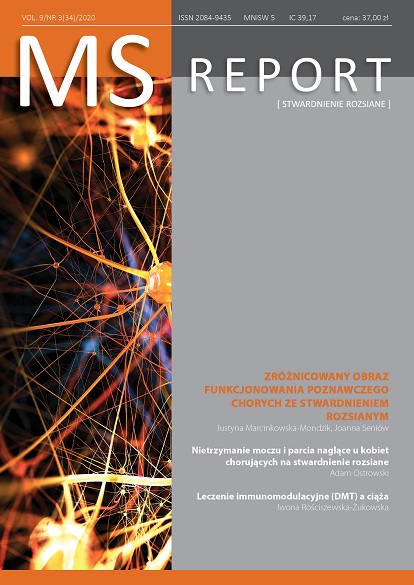Urinary incontinence and urgency in women with multiple sclerosis Review article
Main Article Content
Abstract
Introduction: Urinary incontinence and urgency have a major impact on quality of life. In patients with multiple sclerosis we observe neurogenic bladder dysfunction, manifested as urge urinary incontinence, overactive or high pressure bladder in approximately 50–90% of patients.
Aim: The aim of the study was to summarize the urological management in patients with multiple sclerosis.
Methodology: This article was based on European Association of Urology Guidelines regarding neurogenic bladder and urinary incontinence. In addition, PubMed database search was performed including current systematic reviews and meta-analysis.
Conclusions: The majority of multiple sclerosis patients will develop lower urinary tract disorders of varying severity. Urodynamic tests and cyclic control of the upper urinary tract should be the standard evaluation modality. This is not only due to concern for the quality of life, but above all the protection of the upper urinary tract. Conservative treatment should always be the first stage of treatment. Drug treatment carries a lot of adverse effects, which is associated with poor compliance. The patient should be well informed about the treatment course. Solifenacin had better tolerance than oxybutynin, polytherapy should also be considered. Botulinum toxin injections are an effective and safe option for patients when drug therapy has failed. An urologist should always be a part of the team treating patients with multiple sclerosis.
Article Details
Copyright © by Medical Education. All rights reserved.
References
2. Ruffion A, Castro-Diaz D, Patel H et al. Systematic review of the epidemiology of urinary incontinence and detrusor overactivity among patients with neurogenic overactive bladder. Neuroepidemiology. 2013; 41(3-4): 146-55.
3. Aharony SM, Lam O, Corcos J. Treatment of lower urinary tract symptoms in multiple sclerosis patients: Review of the literature and current guidelines. Can Urol Assoc J. 2017; 11(3-4): E110-5
4. de Seze M, Ruffion A, Denys P et al. The neurogenic bladder in multiple sclerosis: review of the literature and proposal of management guidelines. Mult Scler. 2007; 13(7): 915-28.
5. Nortvedt MW, Riise T, Myhr KM et al. Reduced quality of life among multiple sclerosis patients with sexual disturbance and bladder dysfunction. Mult Scler. 2001; 7(4): 231-5.
6. Yonnet GJ, Fjeldstad AS, Carlson NG et al. Advances in the management of neurogenic detrusor overactivity in multiple sclerosis. Int J MS Care. 2013; 15(2): 66-72.
7. Fowler CJ, Panicker JN, Drake M et al. A UK consensus on the management of the bladder in multiple sclerosis. J Neurol Neurosurg Psychiatry. 2009; 80(5): 470-7.
8. Amend B, Hennenlotter J, Schafer T et al. Effective treatment of neurogenic detrusor dysfunction by combined high-dosed antimuscarinics without increased side-effects. Eur Urol. 2008; 53(5): 1021-8.
9. Tijnagel MJ, Scheepe JR, Blok BF. Real life persistence rate with antimuscarinic treatment in patients with idiopathic or neurogenic overactive bladder: a prospective cohort study with solifenacin. BMC Urol. 2017; 17(1): 30.
10. Wagg A, Compion G, Fahey A et al. Persistence with prescribed antimuscarinic therapy for overactive bladder: a UK experience. BJU Int. 2012; 110(11): 1767-74.
11. Zachariou A, Filiponi M, Baltogiannis D et al. Effective treatment of neurogenic detrusor overactivity in multiple sclerosis patients using desmopressin and mirabegron. Can J Urol. 2017; 24(6): 9107-13.
12. Zachariou A, Mamoulakis C, Filiponi M et al. The effect of mirabegron, used for overactive bladder treatment, on female sexual function: a prospective controlled study. BMC Urol. 2018; 18(1): 61.
13. Yuan H, Cui Y, Wu J et al. Efficacy and Adverse Events Associated With Use of Onabotulinumtoxin A for Treatment of Neurogenic Detrusor Overactivity: A Meta-Analysis. Int Neurourol J. 2017; 21(1): 53-61.
14. Bartley J, Gilleran J, Peters K. Neuromodulation for overactive bladder. Nat Rev Urol. 2013; 10(9): 513-21.
15. de Seze M, Raibaut P, Gallien P et al. Transcutaneous posterior tibial nerve stimulation for treatment of the overactive bladder syndrome in multiple sclerosis: results of a multicenter prospective study. Neurourol Urodyn. 2011; 30(3): 306-11.
16. Krebs J, Bartel P, Pannek J. Functional outcome of supratrigonal cystectomy and augmentation ileocystoplasty in adult patients with refractory neurogenic lower urinary tract dysfunction. Neurourol Urodyn. 2016; 35(2): 260-6.

